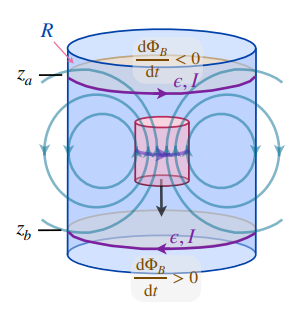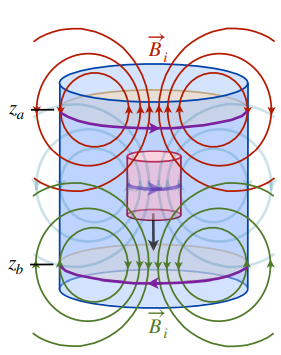PX157 - D1f - a falling magnet in a pipe

-
TLDR:
- flux at the top decreases, and at the bottom increases
- emf at the top is positive, and at the bottom is negative
- eddy currents are generated in each part: CCW at the top and CW at the bottom
- magnetic fields induced: same polarity as magnet at the top, and opposite polarity at the bottom
- the top part attracts the magnet as it falls into the pipe
- once inside, the top part keeps attracting the magnet while the bottom part repels it, slowing it down
- reaches a terminal velocity once the deceleration equals
- there is also a radial force, but they cancel out
-
a magnet with a magnetic dipole moment ,
, in the -direction, and a surface current, , is in the -direction -
the magnet has a mass,
, and falls due to gravity, -
- at
the magnetic flux decreases, - at
the magnetic flux increases,
- at

-
from faraday's law:
- at
an emf, , generated is counter-clockwise - at
and emf, , generated is clockwise
- at
-
from ohm's law:
- the material has a finite resistance,
drives a circular (eddy) current in the same direction - at
counter-clockwise - at
clockwise
- at
- the material has a finite resistance,

- from ampere's law:
- at
- at
- at

- force on the magnet:
forces in the radial direction cancels out - because
- the magnet feels an additional force pushing it upwards, acting as a frictional force whose strength is dependent on the resistivity of the material, and is proportional to the magnet's velocity
